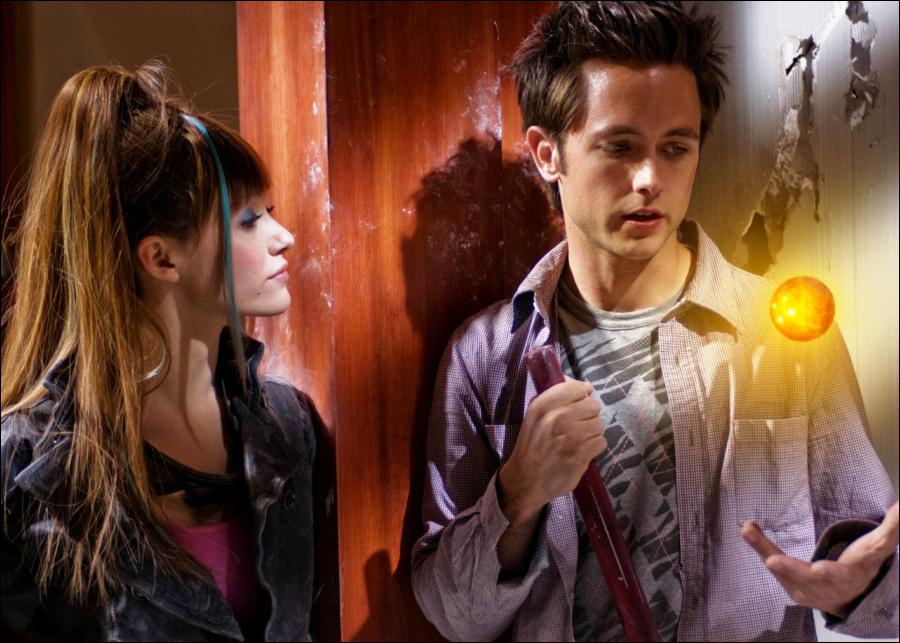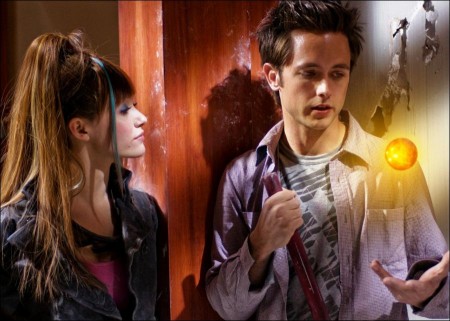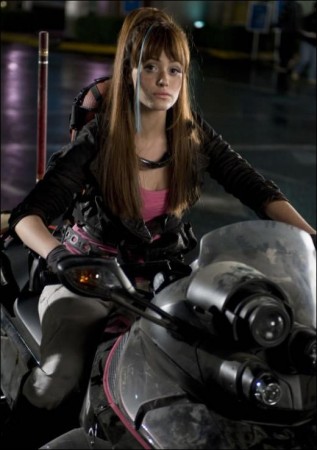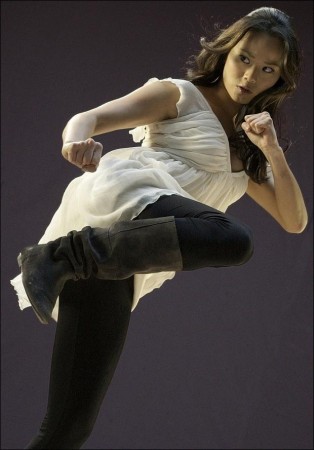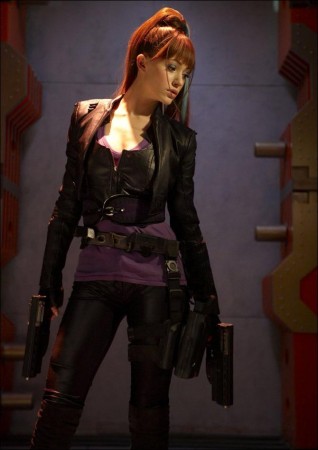Introduction
“Dragonball: Evolution” is the long-awaited, live-action motion picture based on the popular Japanese manga created by Akira Toriyama. Toriyama’s work spawned best selling graphic novels, videogames and a phenomenally successful television series.
The manga, series and games bring to the new film a rich mythology and exciting, complex characters – all of which have captivated millions of fans, of all ages, around the globe. One of the greatest manga franchises ever created, Dragonball has an enormous online fan base and is consistently one of the most frequently searched-for terms on Google and Yahoo!
Dragonball has exploded into a global phenomenon that has generated more than four billion dollars in merchandising sales. It is considered the gold standard of anime-based video games, with more than 25 different games and over ten million units sold since May 2002. The series – 500 episodes strong – posted top ratings in Europe, Asia and the U.S.
The motion picture “DRAGONBALL: EVOLUTION” features a cast of rising young stars and veteran acclaimed actors. Justin Chatwin, who portrayed Tom Cruise’s son in Steven Spielberg’s “War of the Worlds,” takes on the role of the heroic Goku, a powerful warrior who protects the Earth from an endless stream of rogues bent on dominating the Universe and controlling the mystical objects from which the film takes its name. Emmy Rossum (“The Day After Tomorrow”) is Bulma, a beautiful woman intent on retrieving the mystical Dragonballs for her own reasons; Jamie Chung (“Samurai Girl”) is Chi Chi, a young martial artist who captures Goku’s eye; and screen legend Chow Yun-Fat (“Crouching Tiger, Hidden Dragon”) is Roshi, the Master who guides Goku on the young man’s epic quest to save the Earth from the forces of darkness.
James Marsters (“Buffy the Vampire Slayer”) is Lord Piccolo, whose return could signal the Earth’s destruction; international performing sensation Joon Park is Yamcha, a charismatic “bad boy” whose schemes could thwart the heroes’ journey; popular Japanese actress Eriko (“Heroes”) is Mai, an assassin who works with Piccolo; Ernie Hudson (“Ghostbusters”) is Sifu Norris, a Master and contemporary of Roshi’s; and Randall Duk Kim (“The Matrix Revolutions”) is Goku’s grandfather Gohan, whose lessons for Goku begins to prepare the young man for the monumental tasks that lie ahead.
Many of these actors underwent a rigorous training regimen under the auspices of the premier stunt performance company, 87Eleven, which has executed or designed some of the biggest action pieces ever seen on film, in pictures such as “The Matrix,” “The Bourne Supremacy,” “Mr. & Mrs. Smith” and “300.”
“DRAGONBALL: EVOLUTION” is produced by legendary filmmaker Stephen Chow whose best known films as an actor, director and screenwriter – “Shaolin Soccer” and “Kung Fu Hustle” – have featured a unique blend of martial arts action, CGI and comedy. The director is James Wong, formerly an executive producer / writer on the noted genre series “The X-Files,” “Millennium” and “Space: Above and Beyond,” and the co-writer/director of the big-screen hits “Final Destination” and “Final Destination 3.” Ben Ramsey (“Love and a Bullet”) penned the screenplay based upon the graphic novel series Dragonball by Akira Toriyama. The Shonen Jump Comics division of the Tokyo-based publishing house Shueisha is the publisher of the Dragonball manga.
Turning a beloved global property into a motion picture event is no easy task, and it took years after Twentieth Century Fox acquired the rights to the graphic novel series Dragonball to make that happen. A big-screen adaptation finally began to come together when filmmaker James Wong, who has worked extensively in the science fiction/fantasy genre, took an interest in the property. Wong recalls: “I read the mangas, which really sparked my interest in the property. The graphic novels take us to a fantastic world with great characters – and they’re a lot of fun.”
Inspired by the manga, Wong and screenwriter Ben Ramsey worked to achieve a mix of action, humor and character relationships for the new movie. “We strove to hit the right combination of the fantastic and the relatable,” says Wong. Huge action set pieces, state of the art visual effects, and elaborate martial arts sequences would be key elements of “Dragonball: Evolution,” but there was also much to explore with the characters, their rich histories.”
“I believe that the appeal of Dragonball, beyond its super-cool action, is the richly creative world that Akira Toriyama invented,” says Ramsey. “There is a complexity and humanity to the superhuman characters who inhabit that world, as well as a sense of optimism that its lead character.”
The challenges in adapting Dragonball for the big screen were formidable, starting with creating a story that would satisfy the hardcore fans and introduce the world to non-fans. “So the concept was to start off in a world that felt familiar, then gradually introduce the fantastic elements of Dragonball, so by mid-movie we are in full on Dragonball mode,” notes Ramsey. “The biggest challenge in adapting a manga or animated series for a live action movie is the burden of reality,” he continues. “Once characters are brought to life by flesh and blood humans, the rules change, if ever so slightly. Animated characters can get away with a lot more than live action characters.”
Ramsey and Wong took note of the fact that the manga’s characters and environments are central to its universal appeal and relatability. “DRAGONBALL: EVOLUTION” is set in the near future, in a multi-cultural environment. It is a world where “future and past become one,” says Wong, and where “race plays no significant role.” To that end, the casting process for the film was, as Wong puts it, “color blind.” The production set up casting offices in Los Angeles, New York, Vancouver, London, Hong Kong and Japan – “the broadest net we’ve ever thrown over a casting process,” notes the director.
Justin Chatwin landed the role of Goku after an exhaustive worldwide search. Goku is a high school student whose innocence and guilelessness are left behind when he begins his hero’s journey. “The character has a great arc – from high school nerd to the planet’s savior,” says Wong. “One minute, Goku is a high school student who doesn’t fit in with his peers; the next, he’s on an incredible quest.” Chatwin sparked to the idea of the hero’s journey, having long been an admirer of the work of mythologists like Joseph Campbell, whose writings often dealt with the role of the hero figure. “Goku begins his journey as an everyday teen who discovers he’s meant for something more,” says Chatwin. “He becomes a symbol of moral good.”
Goku’s transformative journey is all well and good, as are his martial arts skills, but a subject of equal scrutiny was the character’s….hair. The legions of Dragonball fans identify Goku through his uniquely styled, spiked coif. “That was my first question to Jimmy Wong,” says Chatwin with a laugh. “`What are you going to do with the hair?’ It’s so important, that even the hair has an arc!” (Goku’s hairstyle evolves through the film into its signature, spiky “do.”)
One of the first steps in Goku’s journey is to seek out Roshi, an elderly Master who completes Goku’s training, helps him unlock the secret of his past – and joins him in a quest to save the world. Roshi is unlike any Eastern Master you’ve seen before; he has an eye for the ladies and favors Hawaiian shirts. According to Wong, the role required nothing less than an iconic actor who could convey the character’s many dimensions and incredible abilities. “We had to really reach high to find our Roshi,” says Wong, “and we decided to just go for it and approach Chow Yun-Fat,” the legendary international superstar who has toplined some of the cinema’s most acclaimed action films, including the Oscar-winning “Crouching Tiger, Hidden Dragon.”
Chow wasn’t an obvious physical match to the Roshi fans know from the manga and anime. Wong explains: “In the manga, Roshi is a quirky, elderly figure, who’s unpredictable. He’s definitely not your traditional Master who dispenses sage advice.” While no amount of makeup and prosthetics could transform the strapping Chow – whom People magazine called one of the 50 most beautiful people in the world, and the Los Angeles Times termed “the coolest actor in the world” – into the diminutive, aged figure of the manga, Chow worked hard to capture the character’s spirit. “I’ve never had the kind of challenge I’ve had with the role of Roshi,” says the actor. “There is so much to him – humor, action, romance, emotion. He has extraordinary powers, but he’s still funny, recognizable and human.”
One of the many ideas the actor proposed for the character was donning gray-tinted contact lenses, hinting at the onset of cataracts. “I thought the lenses would add to the realism and relatability of Roshi,” says Chow, who also regularly practiced Tai Chi and mediation before and during the shoot.
Thrilled to be working with a cinema icon, the cast and crew were equally impressed with Chow’s work ethic off camera. He never retreated to his trailer to relax between scenes, and would often help out the camera crew – including moving heavy equipment (becoming the most high-profile grip in the business). “Chow never left the set,” marvels director of photography Robert McLachlan, ASC/CSC. “He was like part of the crew.” But to Chow, his behind-the-scenes work was not a big deal. “It’s how we’ve been doing things in Hong Kong since the beginning of my career in television,” he points out. “The crews were tiny, and we always helped each other out.”
Chow was an inspiration to all, especially the younger actors like Justin Chatwin and Jamie Chung. Chung has the lead role in the popular ABC Family series “Samurai Girl,” whose title character possesses fighting skills that came in handy for “DRAGONBALL: EVOLUTION”. One of today’s brightest and most appealing young stars, Chung brought much more to Chi Chi than martial abilities. She has the sparkling energy necessary to fully capture the two sides of the character. “Chi Chi is the `It Girl’ – the most popular girl in high school,” says Chung. “She comes from a wealthy family, and everyone expects certain things from her. But she has a second life – a secret life – marked by her passion to fight. She comes off like the girl next door, but when she turns it on, she kicks butt!”
The burgeoning relationship between Chi Chi and Goku comes from, in part, them being kindred spirits. “Chi Chi is drawn to Goku’s secret ability to fight,” says Chung. “She feels there’s something really special about Goku, and she’s able to bring that out in him.” Another beautiful young woman joining Goku in his quest is Bulma, a scientist described in the manga as the “smartest girl in the world.”
The film retains the manga character’s confidence, intensity and intelligence – and the fact that she knows exactly what she wants. And what Bulma wants is the Dragonball stolen from her father’s company. Wielding a laser-guided, high-tech magnum pistol and a Dragonball-tracker, Bulma will do anything to retrieve the five-starred Dragonball, which she thinks will supply an unlimited source of energy – and immense financial rewards.
Emmy Rossum appreciated the challenges of playing such a multi-faceted character whose hard-nosed, take-no-prisoners attitude begins to change after she joins Goku and Roshi on their search for the Dragonballs. “Bulma comes to realize that life is about much more than her personal quest,” says Rossum. “The character in the manga and now our film is so alive, funny and spunky. She’s anything but ordinary.” A bonus for the actress was learning to ride Bulma’s speedster, which the production created from a Harley motorcycle.
In the manga, Bulma sports a blue bob, which became her signature look. Rossum recalls that the filmmakers tried different ways to capture that coloring and style, including dyes, hair extensions and wigs, but ultimately went in a more realistic direction. Nevertheless, there are traces of blue and purple laced throughout the character’s wardrobe.
In their search for the Dragonballs, Goku, Roshi and Bulma face their adversary, Lord Piccolo. As depicted in the manga, Piccolo is a complex and intriguing figure whose journey sees him embodying both good and evil. For in the Dragonball mythos, any character can turn from good to evil, and vice versa. James Marsters, beloved to millions of fans around the world for his lengthy stint as the vampire Spike in the hit television series “Buffy the Vampire Slayer” and “Angel,” portrays Piccolo in the film. His Piccolo is the story’s antagonist – “In the film, Piccolo is a figure of decrepitude, and his goals are centered on revenge,” says Marsters – but there are hints that his journey is very much an evolving process.
Working with Piccolo is Mai, an exotic beauty tainted by malevolence. Her weapons of choice are throwing knives known as shiruken. Japanese-born actress Eriko, who came to “DRAGONBALL: EVOLUTION” after wrapping a recurring role on “Heroes,” says she enjoyed playing a “strong, tough woman on a mission.” James Wong adds that Eriko gives the role a “special quality and toughness.”
Rounding out the starring cast is Joon Park as Yamcha. Looking to get rich, quickly, Yamcha traps Goku, Roshi and Bulma in the desert. But eventually, he joins them in their journey. Park, a rock star in his native Korea, has performed in front of 100,000 screaming fans – an experience that helped him capture the essence of the character.
“Joon has all the qualities necessary for Yamcha, including charisma and a sense of mischief,” says Wong. “Yamcha is tough on the outside, but inside there’s a soft heart,” adds Park. “Something in his past has scarred him, and he likes to skim across the details of life, looking for money.”
Action
“How do we make action sequences look and feel different from what audiences have experienced before?” That was the first question Wong posed to his team when he began thinking about the action fans would expect from a film based on Dragonball. The answers coming from the acclaimed stunt team, 87Eleven, as well as from director of photography Robert McLachlan and visual effects supervisor Ariel Velasco Shaw, certainly pleased Wong – and promise to delight not only fans of the property, but action movie enthusiasts as well.
VFX supervisor Velasco Shaw employed what Wong calls “fist-cams” – from the noted company Iconix – that are so small they could be attached to an actor’s fist, allowing a character’s punch to come right into the audience. “It’s a kind of `fist POV’,” Wong elaborates. McLachlan contributed the suggestion of using new high-speed digital Phantom cameras to create super-slow motion for key action sequences. “We did a lot of research and development with the Phantom cameras,” says McLachlan, who had discovered the-then experimental photography on YouTube. In the YouTube video, a balloon filled with water was popped, with the “action” caught at 1000 frames per second. McLachlan and Wong were impressed with the results. “The most spectacular thing about it was that the water retained the shape of the balloon before it fell,” Wong remembers.
More “low-tech,” but equally important to amping-up the action, were the training and stunts overseen by 87Eleven, and stunt coordinators Jonathan Eusebio, Julian Bucio Montemayor, and Jared Eddo. Their first order of business was to get the cast in shape, followed by having them undergo an intensive program of action choreography, and finally, making the actors comfortable with the considerable wire work and acrobatics they’d be required to perform. It was an incredibly rigorous program – “When [the actors] weren’t working, they were training,” says Eusebio.
The young cast members underwent individually-designed training regimens – no two characters have identical fighting styles – as well as special diets to maintain their strength and stamina during production. In Dragonball lore, Goku is the greatest warrior on the planet. And Justin Chatwin took the responsibility of capturing the character’s skills, very seriously. Before the start of principal photography, he underwent six weeks of nutritional guidance and stunt and martial arts training with 87Eleven, continuing the demanding regimen during the shoot. “It all got my adrenalin going,” says the actor, who also notes he gave up sugar, wheat and pasta during his stint on the film. Chatwin spent a minimum of five hours training each day, studying karate, kung fu and a Brazilian form known as capoeira, which ritualizes movement from martial arts, games and dance. For the more extreme acrobatic maneuvers, Jackson Spidell stood in for the actor. Spidell’s signature move: flipping up in the air, then spinning halfway, and, on his way down, striking an opponent.
Chow Yun-Fat, as Roshi, was given “softer” martial styles, like Tai Chi, befitting the character’s age and experience. Jamie Chung, as young and ever-enthusiastic martial artist Chi Chi, was given “hard” fighting styles, including kickboxing, karate, and Thai boxing. Chung especially delighted in a pivotal fight scene that has Chi Chi fighting…Chi Chi. (Mai, a shape shifter, morphs into Chi Chi to steal a Dragonball.) “I had to play both sides of the fight and learn choreography for both Chi Chi and Mai,” the latter a kung fu practitioner, Chung recalls. Visual effects, including motion control and split composites, enhanced the complex battle.
And what kind of training is required for the actor playing one of the most powerful figures in the universe – Lord Piccolo? According to James Marsters, it was drills involving punching / kicking / blocking combinations. “I thought my body would break,” says the actor with a laugh. “But [the stunt team and trainers] knew exactly what my body could take.”
An early scene that sees Goku and his grandfather Gohan training on a laundry line, several feet above ground, was one of the stunt team’s favorites. “Gohan and Goku are fighting, but in a playful way,” explains stunt coordinator Jared Eddo. “Five riggers and a stunt crew of eleven, including doubles and safety experts, were involved in the scene. Pulleys and machines – along with old-fashioned manpower – allowed us to create the illusion that the characters were standing on the laundry line, and a [special rig] allowed us to maneuver the stunt people and actors.”
A climactic clash between Goku and Piccolo, set at the elaborate “Dragon Temple,” was executed and photographed as an all-out brawl, taking no less than ten day days to complete. Here, Goku executes his signature martial arts movie, “Kame-Hame-Ha,” in which he summons energies, both alien and earthly to launch a blindingly intense bolt towards his adversary. For the scene, Justin Chatwin and James Marsters were required to leap from twenty-feet above the Temple’s floor, and appear to “fly” up to some rocky ledges – all with the help of wires and cables, of course. Later, they battled in “mid-air,” suspended in front of a green screen.
Designing “Dragonball Evolution”
The unique look of the film’s action scenes complements its art direction and cinematography. Production designer Bruton Jones, along with visual consultants Richard Holland and Bruce Crone, referenced the Dragonball manga and anime, as well as a melting pot of styles reflecting the film’s multicultural, past/future reference points. The Dragon Temple, for example has Russian, Japanese and Chinese architectural influences.
Before production started, director of photography Robert McLachlan tested various film stocks before going with Fuji, which helped provide the heavily color-saturated look he was after. The color saturation adds to the intensity of the film’s solar eclipse, which in the story signals a potentially cataclysmic event. “We wanted our eclipse to be much more surreal [than a typical solar eclipse], with weird, intense, reddish colors,” says McLachlan.
Ariel Velasco Shaw oversaw the film’s many and varied visual effects, including the energy force known as Ki. Harnessing the power of Ki is one of the central tenants of Eastern philosophy – and connects the incredible goings-on of Dragonball to our real world. In the “air bending” technique of Ki, the practitioner pushes out from his or her chest, causing the air around them to ripple with distortion – and the ensuing energy force to impact their opponent. Ki is so strong that it draws the power of the universe as it is channeled through the practitioner skilled in its technique. Its ultimate manifestation is Goku’s “Kame-Hame-Ha” move.
Velasco Shaw and his team created various, character-appropriate forms of Ki. For example, a human character would possess a different Ki than an alien or a human-alien hybrid. Moreover, there’s a “younger” Ki for the more youthful characters, and an “older,” more developed Ki for Roshi.
The iconic and mystical Dragonballs were largely the creation of the visual effects team. “Everybody had an idea about what they should look like and what they needed to do,” Velasco Shaw says. The Dragonballs, courtesy of some intensive CG magic, have an otherworldly luminescence befitting their numinous properties.
Velaco Shaw also oversaw the two fully-realized CG creations: the monstrous creature Oozaru, as well as the Fu Lum, demon assassins, who regenerate when dismembered. Alec Gillis and Tom Woodruff, Jr., principals of one of the industry’s top special makeup and prosthetics houses, Amalgamated Dynamics Inc. (ADI), designed and created the prosthetic makeup for Lord Piccolo. The sophisticated prosthetics for Lord Piccolo, designed by Gillis and Woodruff, were applied by prosthetic makeup artist Edward French.
About the Locations
“DRAGONBALL: EVOLUTION” began production in Mexico City, where a private, ultra-modern school stood in for Goku’s high school. More than one hundred students were used as extras filling in the classrooms, parking lots and hallways. A sprawling private mansion in an exclusive residential area with English Tudor and Asian architectural elements was utilized for a high school party scene. An area within the city limits became Paozu City, where Roshi lives in a shack situated amidst towering skyscrapers.
After six days of filming in Mexico City, the production moved to Durango, Mexico, where the rest of the filming took place. “Durango has the spectacular outdoor locations including the high mountains, rock formations and deserts we required,” says executive producer Tim Van Rellim, who had worked on a film production in Durango a decade earlier. The production transformed an abandoned jeans factory with a million square feet into a working studio production facility with office, storage and mill spaces, along with a wardrobe warehouse, practical soundstages, and a ten-acre outdoor area that was turned into a backlot for outdoor sets.
High mountain desolate rock formations at Mexiquillo became the secret Toi San training facility. Over 200 local Durango martial artists and their instructors were recruited and transported to the remote location for a big martial arts training scene. The cast and crew faced daily extremes in temperatures from chilly early morning lows of 30 degrees (Fahrenheit) to hot afternoon highs of 80 degrees (F.), as well as occasional dust storms fanned by windy conditions. Later in the shoot, the filmmakers utilized a major recreation facility in Durango as the location for the Toi San Tournament competition arena. One thousand extras filled the structure, cheering the action.
Los Organos State Park, with its spectacular rock formations that resemble church organ pipes, became the setting and inspiration for the story’s Dragon Temple, where pivotal action set pieces where captured. Towering desert sand dunes, called “Las Dunas De Bilbao,” north of Durango, were used for traveling scenes and as the exterior of a desert cavern in Yamcha’s habitat.
The Toi San marketplace was realized out of a grain storage facility from the 1800s that was found just outside of Durango. New architectural elements were added and then enhanced by set decorations mixing Middle Eastern elements with a flea market atmosphere.
Interior sets constructed and housed at the Jeans factory production facility, included the two-story interior of Roshi’s shack, a 20 foot high cavern interior, the Toi San Temple courtyard and corresponding interiors, Lord Piccolo’s Genesis Chamber and dirigible, as well as the green screen sets.
Production notes provided by 20th Century Fox.
Dragonball: Evolution
Starring: Justin Chatwin, James Marsters, Jamie Chung, Emmy Rossum, Eriko Tamura, Joon Park, Chow Yun-Fat, Texas Battle
Directed by: James Wong
Screenplay by: James Wong
Release Date: April 8th, 2009
MPAA Rating: PG for intense sequences of action/violence and brief mild language.
Studio: 20th Century Fox
Box Office Totals
Domestic: $9,362,785 (16.3%)
Foreign: $48,134,914 (83.7%)
Total: $57,497,699 (Worldwide)
